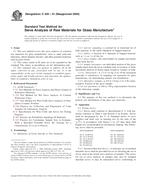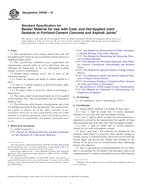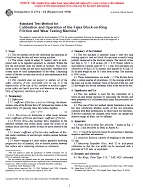1.1 This test method covers a procedure for estimating the long-term change in thermal resistance of unfaced rigid closed cell plastic foams by reducing the material thickness to accelerate aging under controlled laboratory conditions (1-3).
1.2 This test method is limited to unfaced, homogeneous materials (see 3.2.4). It may be applied to a wide range of rigid closed cell plastic foam types, including but not limited to, polystyrenes, polyurethanes, polyisocyanurates, and phenolics produced in board form, foamed-in-place, or spray-applied applications. No specific procedures are detailed in this test method to address the effects of permeable or impermeable facings or skins, manufactured thickness, orientation, manufacturing process, density, quality, the influence of structures or containments, or the end-use environmental conditions on internal cell gas composition. The user of this test method shall consider if these parameters limit the use of this test method for a specific application.
1.3 This test method utilizes standard test procedures for measuring the thermal resistance of insulation materials. Periodic measurements are performed on specimens to observe the effects of aging. Specimens of reduced thickness are used to shorten the time required for these observations. The results of these measurements are coupled with a scaling factor to estimate the thermal resistance of the material under evaluation for other thicknesses as a function of time.
1.4 This test method specifies methods of specimen preparation, procedures for determining the specimen effective diffusion thickness (see 3.2.3), and precautions for determining the thermal resistance of thin specimens.
1.5 The values stated in SI units are to be regarded as the standard. The values given in parentheses are for information only.
1.6 This test method should be used to measure and describe the relative change in thermal resistance of rigid closed cell plastic foams under controlled laboratory conditions. It should not be used to describe or appraise the performance of these materials or products under actual use conditions. With continuing development, results from this test method may be used as an element in an assessment which takes into account all of the factors that are pertinent to an estimation of the thermal performance of these materials. Critical elements of this assessment are presently not available. See 1.2.
1.7 This standard does not purport to address all of the safety concerns, if any, associated with its use. It is the responsibility of the user of this standard to establish appropriate safety and health practices and determine the applicability of regulatory limitations prior to use.
Product Details
- Published:
- 03/10/2000
- Number of Pages:
- 9
- File Size:
- 1 file , 110 KB


